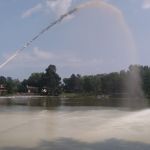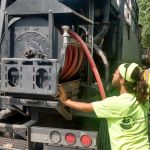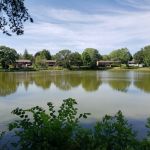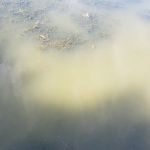Oak Knoll Pond/Wood Lake Spent Lime Demonstration Project
Oak Knoll Pond/Wood Lake project status:
Spent lime application began during the fall of 2023 and continued into 2024. In spring 2024, the project resumed on April 9. The final spent lime application was completed on July 26.
Monitoring was an important part of the project during applications. Ongoing monitoring will continue to determine potential results of the spent lime treatment and longevity.
Project partners are especially appreciative of support and access granted by residents around the pond/lake.
Quick Facts:
- Spent lime is produced during drinking water treatment. Lime is used to “soften” water by removing calcium and magnesium ions. The resulting spent lime can be added to waterbodies to bind with phosphorus to remove it from water.
- Excess phosphorus in fresh waterbodies fuels algae blooms, which limit plant growth. Algae blooms can also produce toxins. Toxin producing algae blooms can be unhealthy for humans, pets and wildlife. In addition, algae blooms are unsightly, limit habitat value for wildlife, and can produce odors when large numbers of algae decay.
- Spent lime is often applied to agricultural fields to reduce soil acidity.
- Spent lime application in waterbodies is permitted by the Minnesota Pollution Control Agency (MPCA). Such permitting was in place for previous experimental projects in small ponds and for the current project in Oak Knoll Pond/Wood Lake.
- This demonstration project is expanding upon previous small-pond experimental projects to investigate if spent lime can be used efficiently to improve water quality in larger bodies of water.
Funding:
Funding for this effort is provided by VLAWMO and the City of White Bear Lake.
Reason for project:
Stormwater ponds are a valuable tool for collecting pollutants, such as phosphorus and sediment, before these pollutants flow into a larger waterbody. Stormwater ponds require maintenance over time to remove pollutants that have accumulated and keep the ponds functioning. Dredging is a common technique for improving pond performance, removing pollutants, and increasing storage capacity. Dredging, transporting, and disposing of the sediment can be costly and disrupts the environment.
The research team at Barr Engineering has been looking at practical alternatives to pond dredging, such as the application of spent lime. Spent lime is available as a byproduct of drinking water treatment. Lime is applied to drinking water to soften the water by removing calcium and magnesium ions. The resulting spent lime still has the capacity to bind to phosphorus. Excess phosphorus in waterbodies stimulates algae blooms and reduces water quality. As a readily available material, Barr Engineering, wondered if spent lime could be used to improve water quality in our ponds, streams, and lakes. Specifically, spent lime would be used to bind phosphorus and keep it in the sediment of a waterbody, where it can’t stimulate algae growth. Barr worked with VLAWMO and Ramsey Washington Metro Watershed District to conduct small pond experiments by treating them with spent lime as part of a research study funded by the University of Minnesota during 2021. Those experiments showed promise. The next step is to test spent lime in larger waterbodies to see if similar positive results can be produces and assess how long they will last.
The overarching goal of the demonstration project in Oak Knoll Pond/Wood Lake is to address the effectiveness of spent lime in a larger waterbody and determine the longevity of the treatment.
Implementation:
Spent lime slurry will be sprayed into the pond during the summer and fall of 2023. Oak Knoll Pond/Wood Lake was selected for the study because of its size, depth, and location. Lab analyses were conducted to determine the buffering capacity of the pond/lake because pH is a sensitive issue when applying spent lime. Buffering capacity means that the pond water and sediment tends to resist changes in pH because of the chemical compositions and interactions. A high buffering capacity means a tendency to resist changes in pH. This work expands upon a 2021 study conducted in Ash Street Pond in Lino Lakes and a separate small pond in Ramsey Washington Metro Watershed District.
Spent lime is sprayed into a waterbody with a hose and quickly sinks to the bottom to treat the sediment. Achieving even coverage of the sediment is important, with a focus on deeper water areas where oxygen is reduced at key times during the year (often late summer and during the winter). During and following the application, monitoring is conducted for possible changes in pH and to analyze how phosphorus levels respond to the spent lime.
The City of White Bear Lake is providing the spent lime for the project.
Findings and discussion:
Find results from the small pond experimental work, including a presentation at the Minnesota Stormwater Seminar Series, at:
U of M Water Resources Center Spent Lime web page
2021 Spent Lime Study project page
Visit the MPCA website for more information on spent lime as a stormwater management tool.
For questions, contact dawn.tanner@vlawmo.org






